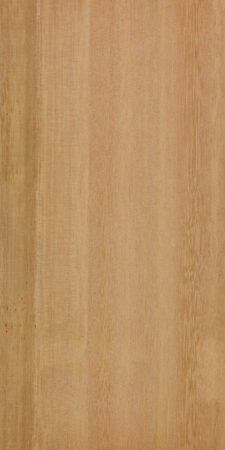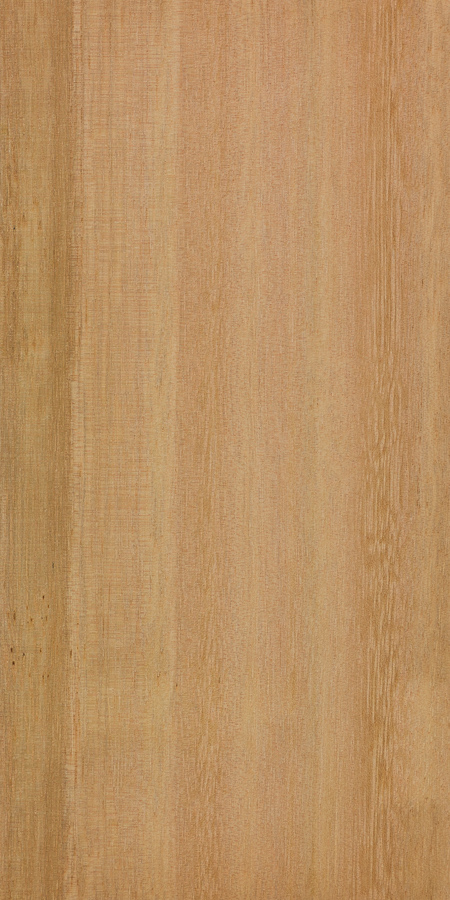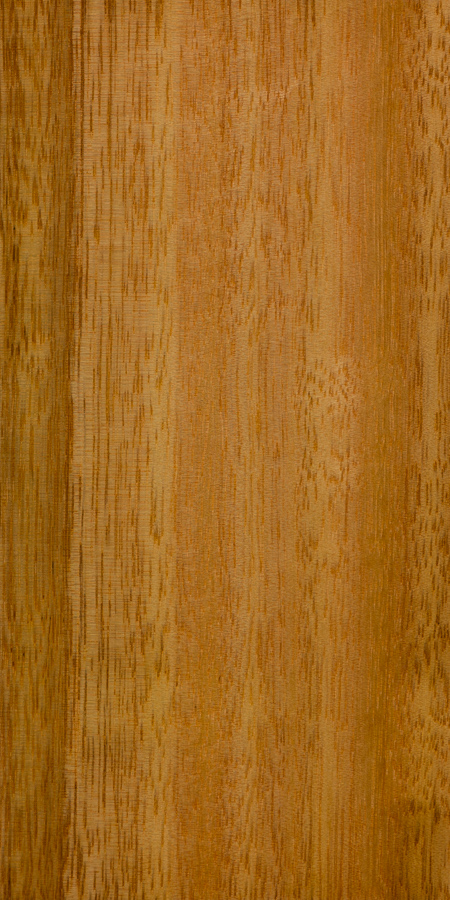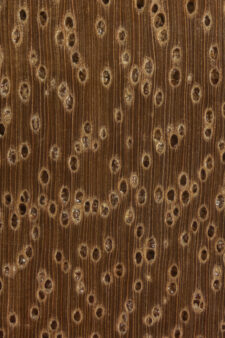DATA SOURCE(S): 1,7,35
Common Name(s): Blue gum, Southern blue gum
Scientific Name: Eucalyptus globulus
Distribution: Tasmania and southern Australia; also widely grown on plantations in subtropical regions
Tree Size: 100-180 ft (30-55 m) tall,
3-5 ft (1-1.5 m) trunk diameter
Average Dried Weight: 51 lbs/ft3 (820 kg/m3)
Specific Gravity (Basic, 12% MC): 0.68, 0.82
Janka Hardness: 2,370 lbf (10,550 N)
Modulus of Rupture: 19,530 lbf/in2 (134.7 MPa)
Elastic Modulus: 2,720,000 lbf/in2 (18.76 GPa)
Crushing Strength: 11,160 lbf/in2 (76.9 MPa)
Shrinkage: Radial: 6.8%, Tangential: 12.8%,
Volumetric: 19.7%, T/R Ratio: 1.9
Color/Appearance: Heartwood is a light yellowish brown. Narrow sapwood is a pale gray/white. Boards with mottled figure are sometimes seen, as well as solid burl sections and veneer.
Grain/Texture: Grain tends to be interlocked, with a uniform medium to coarse texture. Low natural luster.
Rot Resistance: Rated as moderately durable, though susceptible to insect attack.
Workability: Gives moderately good results with hand and machine tools, though boards with interlocked grain (especially on quartersawn surfaces) frequently causes tearout during planing and other surfacing operations. Blue gum tends to have many internal stresses and drying difficulties, and also has a large amount of movement in service, which excludes it from being used in applications where stability is important. Glues and finishes well.
Odor: No characteristic odor.
Allergies/Toxicity: Although severe reactions are quite uncommon, blue gum has been reported to cause skin irritation. See the articles Wood Allergies and Toxicity and Wood Dust Safety for more information.
Pricing/Availability: Plantation-grown lumber is regularly available (sometimes sold simply as “eucalyptus”) and is moderately priced for an imported hardwood. Figured boards and burls are likely to be much more expensive.
Sustainability: This wood species is not listed in the CITES Appendices, and is reported by the IUCN as being a species of least concern.
Common Uses: Utility lumber, pallets, paper (pulpwood), fenceposts, flooring, veneer, and turned objects.
Comments: Sometimes called southern blue gum to help distinguish it from Eucalyptus saligna, commonly called Sydney glue gum. This species also currently has four recognized subspecies:[1]CANBR. (2020). Eucalyptus globulus subsp. globulus. EUCLID.
- Eucalyptus globulus ssp. bicostata—Victorian blue gum
- Eucalyptus globulus ssp. globulus—Tasmanian blue gum
- Eucalyptus globulus ssp. maidenii—Maiden’s gum
- Eucalyptus globulus ssp. pseudoglobulus—Victorian eurabbie
This fast-growing tree is widely cultivated as a plantation species within Australia and other subtropical climates. Plantation grown lumber tends to be lighter and softer than forest-grown blue gum. The wood is primarily used for pulp and fuel, though some is harvested for woodworking purposes. Blue gum is generally regarded as a utility lumber.
Images: Drag the slider up/down to toggle between raw and finished wood.
A special thanks to Steve Earis for providing a wood sample of this species.
Identification: See the article on Hardwood Anatomy for definitions of endgrain features.
Porosity: diffuse porous
Arrangement: exclusively solitary
Vessels: large to very large, few to very few; tyloses common
Parenchyma: diffuse-in-aggregates and vasicentric (visible parenchyma is generally very minimal)
Rays: narrow width; normal to close spacing
Lookalikes/Substitutes: Can bear a close resemblance to other Eucalyptus plantation species, such as mountain ash (E. regnans) or the hybrid lyptus (E. urograndis). Separation of eucalypts down to a species level can be very difficult and usually isn’t possible on the basis of endgrain anatomy.
Notes: Exclusively solitary pores is a fairly uncommon anatomical feature that can help separate blue gum from a host of other diffuse porous hardwoods.
Related Content:











I’m trying to determine the species of this wood baseboard I plan on refinishing. Looks like Blue Gumwood but would like a pro opinion. Thanks in advance.
Does not glue well though. Where’d that come from?
Hello. I bought sculptures made from Blue gum wood and they are cracking and changing colour. Please advise on how I can treat the sculptures.
Many thanks
Are Blue gums any good for bridge beams?
Hi
My experience with bluegum from southern Tas is that is yellow(ish), but some pink at times. I haven’t used it for doors or furniture, but older bluegum is very hard and being quite cross-grained and good oil content, is great for decking timber (I leave mine rough sawn on top).
It says that it has some stability issues, I have about seven 50mm thick slabs cut for me, and Im planing to make a guitar out of one of them. Do you think if would be able to withstand the tension, or would it deform/bend? Btw the bluegum wood I have is a south-africa species, im not sure if that would make it easier.
Hi, kindly suggest which is best species of Eucalyptus for Furniture and door frame.
Hi Everyone!
I’m new to the world of arborists. There was a large Blue Gum Eucalyptus that fell two weeks ago. I had some pretty large pieces (80″ x 50″) brought back to my property to get milled. I have x7 2.5″ slabs stacked now. I’m wondering if there’s any special treatment I should do while it dries? I notice some cracks forming on the ends.
Thanks!
You will want to seal the ends with something, preferably wax, or even paint or glue would work.
This article is incorrect. Blue Gum is a red timber and very durable. I work with it daily and the picture above is not consistent with what I look at daily for the past 10 years
Maybe we are not talking about the same species? Keith Bootle describes this wood as “Heartwood pale brown, sometimes with a pinkish tinge” in Wood in Australia. Also, Martin Chudnoff’s Tropical Timbers book describes the color and durability as I have it on this page. https://www.fpl.fs.fed.us/documnts/TechSheets/Chudnoff/SEAsian_Oceanic/htmlDocs_SEAsian/Eucalyptusglobulus.html
Around here (Northern NSW) Blue Gum is always red or red/pink and refers to Eucalyptus saligna. Not a criticism, just letting you know.
Yes, I have probably about 50 more species of Eucalyptus that I’ve yet to add to the site, so at some point this will probably get renamed to the more precise “Southern blue gum.”
Why wouldn’t there be a characteristic eucalypt smell with all the eucalypt woods????
I assumed my floor boards were pine, till I started sanding- then it was obvious they were some kind of (very light fairly knotty) eucalyptus…. the smell was very strong.
The eucalyptus smell is from the leaves, I’ve not found that this odor translates to the wood itself. Are you basing the ID of your floor boards on the odor? With the exception of some closely related species of Corymbia (which can smell like lemons) most eucalypts do not have a strong smell.
Please can someone tell me how Bluegum should be drie at home in small quantities? If cut into small 300mm rounds with endgrain up, quick dried? Thanks.
As all eucalyptus species this species, known as blue gum are difficult to dry. Especially when MC is above FSP. This is because of the small pith openings and enormus variation in density across the year ring. The level of under-pressure due to small pith openings developed during too high drying rate is causing cell collapse. Because of enomeous tension due to cell collaps and low density with low resistance to tension in the early wood this can lead to honeycombing and internal cracks.
made my front door from this timber, lovely red/orange colour and very hard timber.
had to hand cut mortises and the timber was hard going to chop a mortise in..